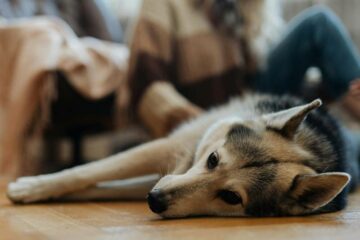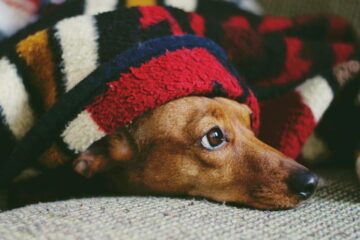Dog Ate Paper Plate? What to Do if Dog Eats Paper Plates!
Dog ate paper plate and you’re not sure how to respond? No worries! In this article, we’ll teach you what to do if your dog ate a paper plate, and the two simple but incredibly effective commands to stop it from happening again. You’ll also learn why dogs eat paper plates and how to treat the root cause of this behavior.
Next, we’re going to cover if dogs can eat paper plates safely, if dogs can digest paper plates, and how long they take to pass. Finally, we’ll fill you in on the signs your dog ate a paper plate and the special considerations when you have a puppy eating paper plates. Keep reading!
Dog Ate Paper Plate

If your dog ate a paper plate, watch them closely for any changes in behavior like vomiting, an unwillingness to eat, or problems passing stool. While paper plates aren’t toxic to dogs, they can pose risks such as gastrointestinal blockage, especially if eaten in large pieces.
My Dog Ate a Paper Plate, What Do I Do?
If your dog ate a paper plate, keep an eye on them for any signs of distress. Look for changes in behavior, loss of appetite, or difficulty in passing stool. Small pieces may pass through their system, but larger fragments can cause blockages. If you notice any concerning symptoms or if the plate was large, contact your veterinarian immediately.
Signs Dog Ate Paper Plate
The signs your dog ate a paper plate include vomiting, diarrhea, abdominal pain, and changes in bowel habits. In some cases, you might see parts of the plate in their stool. If the plate causes an obstruction, your dog may exhibit signs of distress, such as whining, pacing, or lethargy. Any of these symptoms warrant a prompt veterinary consultation.
Train the “Leave It” Command
Training your dog with the “Leave It” command can help prevent them from eating paper plates:
- Start with a less tempting item and hold it in your hand. When your dog approaches, say “Leave it.”
- Once they back away, reward them with praise and a treat from the other hand.
- Gradually increase the challenge by using more enticing items, like paper plates, always rewarding compliance.
- Practice regularly in different settings to reinforce the command.
Train the “Drop It” Command
The “Drop It” command can also be useful for preventing your dog from eating paper plates:
- Give your dog a toy to hold, and when they have it, offer a treat while saying “Drop it.”
- Once they release the toy, praise them and give the treat.
- Repeat this process, gradually introducing items like paper plates under supervision.
- Ensure consistency in training to achieve the best results.
In summary, if your dog eats a paper plate, it’s important to monitor them for any signs of gastrointestinal distress. Training them on these commands can help prevent such incidents in the future, but it’s important to remember that the underlying behavioral issues (curiosity, anxiety, boredom, etc.) that were causing all of this to begin with will still be present.
And until you address those, any positive changes you see will only be temporary.
“Well, how do I make these changes last?”
By getting your dog to truly choose to follow your direction, that’s how. I tried many times to write out how you can do that before deciding it made more sense to just link you to the free video series that explains it better than I’d ever be able to.
The series is by a man named Dan who is one of the world’s leading dog obedience trainers. In it, he teaches you how to put an end to things like your dog eating paper plates and all other misbehavior using his fast and easy-to-follow methods.
In the first video, Dan will reveal to you why the two most common methods of dog training only doom you to failure. You can watch the video now by clicking here. Follow the proven system he’ll show you in his series and you’ll never have to spend another second worrying about what to do if your dog ate a paper plate ever again!
Why Do Dogs Eat Paper Plates?

Dogs eat paper plates because they are often attracted to the remnants of food, the texture, or simply out of curiosity. This behavior can also be a sign of boredom or anxiety. While paper plates are not toxic, eating them can pose a risk of gastrointestinal blockages, especially if consumed in large quantities.
Why Is My Dog Eating Paper Plates?
Your dog is eating paper plates likely due to the scent of food that lingers on them. Dogs have a strong sense of smell, and even small traces of food can be enticing. Additionally, some dogs chew on paper plates out of boredom, lack of mental stimulation, or seeking to relieve anxiety. Chewing releases soothing endorphins for dogs.
Teaching your dog commands like “leave it” and “drop it” will be perfect for these types of situations. You can learn both now by going back to the first section.
You should take care of this as soon as you can, as doing so will also keep your dog safe during other similar situations. You then aren’t going to have to worry about things like why dogs eat paper or what to do if your dog ate tape, if your dog ate a muffin wrapper, or if your dog ate a cupcake wrapper.
Puppy Eating Paper Plates
If your puppy ate paper plates, it might be part of their natural exploration and teething process. Puppies are known to chew on various objects as they explore their environment and deal with the discomfort of teething. However, it’s important to discourage this behavior to prevent the risk of ingestion and potential intestinal blockage.
Dog Eating Paper Plates: How to Prevent
Preventing your dog from eating paper plates involves managing their environment and access to these items. Ensure that paper plates are immediately disposed of in a secure trash can with a lid. Keeping your dog’s environment clean and free of debris can significantly reduce the temptation.
Additionally, provide plenty of appropriate chew toys and engage in regular interactive play to keep your dog mentally and physically stimulated. This can help redirect their chewing behavior towards more suitable objects and reduce the likelihood of them seeking out paper plates or other inappropriate items to chew on.
In summary, dogs eat paper plates due to the lingering smell of food, curiosity, or as a result of boredom or anxiety. Understanding the reason behind this behavior is key to addressing it effectively (learn more in the first section). Taking steps to prevent access to paper plates and providing suitable alternatives for chewing can help mitigate this behavior.
Can Dogs Eat Paper Plates?

Dogs can’t eat paper plates safely. While they might be able to physically chew and swallow them, paper plates are not digestible and can pose serious health risks to them. Your dog eating paper plates can lead to gastrointestinal blockages and other complications, making it important for you to prevent access to them.
Can Dogs Digest Paper Plates?
Dogs cannot digest paper plates. The materials in paper plates are not broken down effectively in a dog’s digestive system. A dog eating paper plates can lead to gastrointestinal blockage, especially if a large piece is swallowed. This can cause symptoms like vomiting, abdominal pain, and constipation, and may require veterinary intervention.
To prevent these types of dangerous incidents before they happen, begin by training your dog on the “leave it” and “drop it” commands. Learn both now in the first section.
Can Dogs Pass Paper Plates?
Whether a dog can pass a paper plate depends on the amount ingested and the size of the dog. Small pieces may pass through a large dog’s digestive system with minimal issues. However, larger pieces or whole plates pose a significant risk of causing intestinal blockages, particularly in smaller dogs.
If you notice any signs of distress like lethargy, vomiting, or a change in bowel habits after your dog ate a paper plate, contact your veterinarian right away.
Dog Ate a Paper Plate: How Long to Pass?
If a dog ate a paper plate, the time it takes to pass, if at all, varies based on the dog’s size and the amount consumed. Some dogs may be able to pass small pieces within a day or two, but larger fragments or whole plates can cause obstructions requiring medical attention.
It’s important to watch your dog for signs of gastrointestinal distress, such as vomiting, loss of appetite, or difficulty in passing stool. Contact your vet immediately if you notice any issues.
In summary, while dogs might be able to ingest small pieces of paper plates, it is not safe for them to do so. Paper plates can lead to digestive blockages and other health issues. If your dog ate a paper plate, you must watch for any signs of discomfort or distress and seek veterinary assistance if necessary.
Keeping paper plates and other potential hazards out of reach is the best way to prevent accidental ingestion.
I’m sure you’re ready now that you have all of your questions about why dogs eat paper plates answered, so I’ll let you get started. Good luck, and thank you for reading our article “Dog Ate Paper Plate? What to Do if Dog Eats Paper Plates!”





